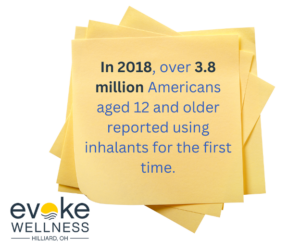Inhaling fumes from common household products to get high, known as huffing, is an extremely dangerous form of substance abuse. You will learn key information about this dangerous practice, including:
- The Effects of Huffing: Brain damage, organ failure, and sudden death are very real risks.
- Who is at Risk: Huffing often starts in adolescence and can become addictive.
- Statistics: There are over 2,000 deaths annually from inhalant abuse in the U.S.
- Getting Help: Drug rehab programs can help people recover from huffing addiction.
Call us at (833) 949-1347 today or reach out online.
What Is Huffing?
A Dangerous Habit
Huffing refers to inhaling fumes from household products to get high. It’s a form of inhalant abuse that can have devastating effects. Huffers breathe vapors from common items like glue, paint thinners, and aerosol sprays.
Widespread Yet Misunderstood
Though often dismissed as a fad, huffing cuts across all ages and backgrounds. Recent surveys found over 21% of students had used inhalants by 8th grade. It’s a cheap, accessible high – making it alarmingly widespread.
Mind-Altering Effects
The volatile substances in inhalants produce a short-lived intoxication. Effects like slurred speech, dizziness, and hallucinations mimic alcohol inebriation. But huffing also starves the brain of oxygen, potentially causing permanent brain damage.
Addictive and Deadly
Inhalants are highly addictive despite the temporary high. Compulsive huffers risk sudden sniffing death syndrome – when inhalants cause fatal heart failure. Treatment involves detox to break the addiction, followed by counseling.
Why Do People Huff?
Escaping Reality
- Many turn to huffing as an inexpensive way to get high and escape reality.
- The easy access to household products makes inhalants an alluring substance for abuse.
Peer Pressure
- Adolescents are particularly vulnerable to peer pressure and experimentation.
- Huffing can start as a dare or an attempt to fit in with a group.
Lack of Education
- There is often a lack of awareness about the extreme dangers of inhalant abuse.
- Without proper education, some view huffing as a “safe” way to get high.
Mental Health Issues
- Those struggling with mental illness may use inhalants to self-medicate.
- Huffing can be a way to temporarily relieve anxiety, depression or other disorders.
The effects are undeniably dangerous and can lead to tragic consequences. Education and access to support services are crucial in preventing this risky behavior.
Health Risks and Dangers of Huffing
Severe Effects
- Coughing, nosebleeds, breathing problems
- Loss of coordination, slurred speech
- Irregular heartbeat, suffocation, seizures
Brain Damage
Inhalants starve the brain of oxygen. This can cause irreversible effects like:
- Vision problems, hearing loss
- Bone marrow damage
- Memory impairment, brain damage
Sudden Sniffing Death Syndrome
- Can occur the first time or after prolonged use
- Heart stops beating due to inhalant’s toxicity
- Leading cause of death among inhalant abusers
Addiction & Withdrawal
Huffing can be highly addictive, leading to:
- Withdrawal symptoms like nausea, sweating
- Strong cravings to keep using inhalants
- Needing higher doses to get same effects
Seeking professional treatment at a rehabilitation center is critical for recovery from inhalant addiction.
Warning Signs of Huffing Addiction
Physical Symptoms
- Nosebleeds or sores around the nose/mouth
- Slurred speech or lack of coordination
- Red or glazed eyes and dilated pupils
Psychological Changes
- Mood swings, irritability or hostility
- Apathy, depression or anxiety
- Memory loss and concentration issues
Behavioral Red Flags
- Paint, glue or aerosol stains on clothes/skin
- Possession of numerous household products
- Social withdrawal and secrecy about activities
Recognizing these signs can help identify huffing addiction early. Inhalant abuse causes irreversible brain damage, organ failure and even sudden death. Get help from an addiction treatment center immediately if you suspect someone is huffing.
Getting Help for Inhalant Abuse and Addiction
Seek Professional Treatment
Inhalant addiction requires specialized care from qualified professionals. Look for addiction treatment centers that offer medical detox, residential rehab, and therapy programs tailored to inhalant abuse. A comprehensive treatment approach addresses the physical, psychological, and social aspects of addiction.
Detoxification and Withdrawal
The first step is safely detoxing from inhalants under medical supervision. Withdrawal symptoms like nausea, tremors, and hallucinations can be severe, so professional care is crucial. Medications may help manage discomfort during this phase.
Therapy and Counseling
Individual, group, and family therapy sessions are vital for understanding the root causes of inhalant abuse and developing healthy coping mechanisms. Cognitive-behavioral therapy (CBT), dialectical behavior therapy (DBT), and trauma therapy help rewire thought patterns and address underlying mental health issues.
Aftercare and Support Groups
Recovery is an ongoing journey that requires commitment and support. Participation in 12-step programs, sober living facilities, and alumni networks provides accountability and a sense of community. Building a strong sober support system enhances long-term success.
Inhalant Abuse FAQs
What are inhalants?
- Inhalants are household, industrial or medical products that produce chemical vapors. When intentionally inhaled or “huffed,” they can cause mind-altering effects.
- Common inhalants include solvents like paint thinners, aerosol sprays, gasses like butane, and nitrites found in room odorizers.
What are the effects?
- Short-term effects include slurred speech, lack of coordination, euphoria and dizziness. Hallucinations and delusions may also occur.
- Long-term abuse can lead to brain, liver and kidney damage. Serious inhalant abusers risk nerve damage, hearing loss and bone marrow problems.
Who’s at risk?
- Inhalants are one of the first substances that young teens abuse, as they are inexpensive and easily accessible products.
- However, inhalant abuse cuts across all socioeconomic groups and ages.
Recent stats on huffing
- In 2018, over 3.8 million Americans aged 12 and older reported using inhalants for the first time.
- Inhalant use peaked among 8th graders at 4.6% in 2020, up from 3.8% in 2019.

Getting help for addiction
- Inhalant addiction treatment usually involves behavioral therapies and support groups.
- Severe withdrawal may require medical detox and medication to ease cravings and other symptoms.
Conclusion
The dangers of huffing are real and can have life-altering consequences. By understanding what inhalant abuse is, its effects, risks, and statistics, as well as considering rehabilitation, you now have the knowledge to make informed decisions. Your future is in your hands. Focus on positive goals that will lead to health and happiness. There are people who care about you and want to help if you feel trapped in addiction. You have so much potential – don’t waste it by huffing. Your life is precious. Value yourself and live each day fully. The choice is yours.
Begin Your Journey with Evoke Wellness at Hilliard
If you or a loved one is considering treatment, Evoke Wellness at Hilliard invites you to contact us. Our compassionate team is ready to answer your questions, discuss your needs, and help you take the first steps toward recovery. In Hilliard, you’ll find more than just a treatment program – you’ll discover a community dedicated to your wellness and success. Together, let’s embrace the journey to recovery and the promise of a new beginning. Call us at (833) 949-1347 today or reach out online.



